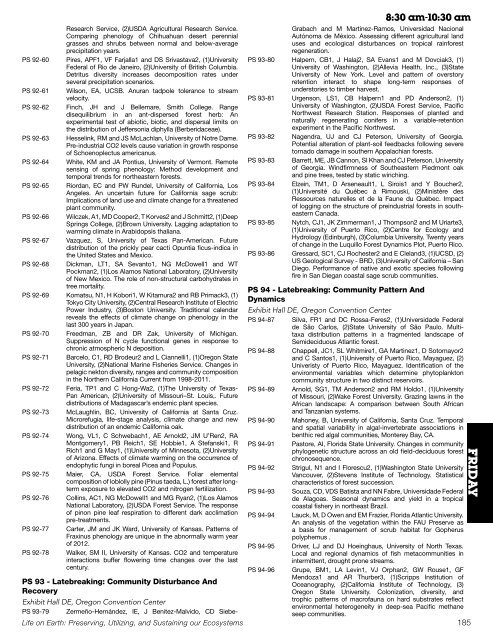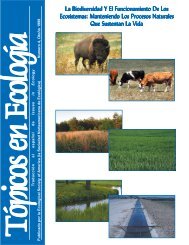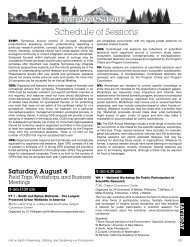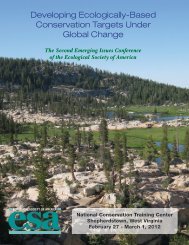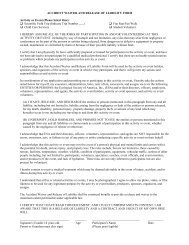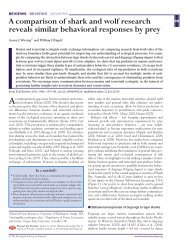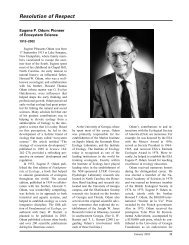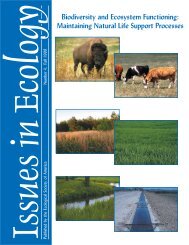Printed Program (PDF) - Ecological Society of America
Printed Program (PDF) - Ecological Society of America
Printed Program (PDF) - Ecological Society of America
Create successful ePaper yourself
Turn your PDF publications into a flip-book with our unique Google optimized e-Paper software.
8:30 am-10:30 am<br />
Research Service, (2)USDA Agricultural Research Service.<br />
Grabach and M Martinez-Ramos, Universidad Nacional<br />
Comparing phenology <strong>of</strong> Chihuahuan desert perennial<br />
Autónoma de México. Assessing different agricultural land<br />
grasses and shrubs between normal and below-average<br />
uses and ecological disturbances on tropical rainforest<br />
precipitation years.<br />
regeneration.<br />
PS 92-60 Pires, APF1, VF Farjalla1 and DS Srivastava2, (1)University PS 93-80 Halpern, CB1, J Halaj2, SA Evans1 and M Dovciak3, (1)<br />
Federal <strong>of</strong> Rio de Janeiro, (2)University <strong>of</strong> British Columbia.<br />
University <strong>of</strong> Washington, (2)Allevia Health, Inc., (3)State<br />
Detritus diversity increases decomposition rates under<br />
University <strong>of</strong> New York. Level and pattern <strong>of</strong> overstory<br />
several precipitation scenarios.<br />
retention interact to shape long-term responses <strong>of</strong><br />
PS 92-61 Wilson, EA, UCSB. Anuran tadpole tolerance to stream<br />
understories to timber harvest.<br />
velocity.<br />
PS 93-81 Urgenson, LS1, CB Halpern1 and PD Anderson2, (1)<br />
PS 92-62 Finch, JH and J Bellemare, Smith College. Range<br />
disequilibrium in an ant-dispersed forest herb: An<br />
experimental test <strong>of</strong> abiotic, biotic, and dispersal limits on<br />
the distribution <strong>of</strong> Jeffersonia diphylla (Berberidaceae).<br />
University <strong>of</strong> Washington, (2)USDA Forest Service, Pacific<br />
Northwest Research Station. Responses <strong>of</strong> planted and<br />
naturally regenerating conifers in a variable-retention<br />
experiment in the Pacific Northwest.<br />
PS 92-63 Hesselink, RM and JS McLachlan, University <strong>of</strong> Notre Dame.<br />
Pre-industrial CO2 levels cause variation in growth response<br />
<strong>of</strong> Schoenoplectus americanus.<br />
PS 93-82 Nagendra, UJ and CJ Peterson, University <strong>of</strong> Georgia.<br />
Potential alteration <strong>of</strong> plant-soil feedbacks following severe<br />
tornado damage in southern Appalachian forests.<br />
PS 92-64 White, KM and JA Pontius, University <strong>of</strong> Vermont. Remote<br />
sensing <strong>of</strong> spring phenology: Method development and<br />
temporal trends for northeastern forests.<br />
PS 93-83 Barrett, ME, JB Cannon, SI Khan and CJ Peterson, University<br />
<strong>of</strong> Georgia. Windfirmness <strong>of</strong> Southeastern Piedmont oak<br />
and pine trees, tested by static winching.<br />
PS 92-65<br />
PS 92-66<br />
PS 92-67<br />
PS 92-68<br />
Riordan, EC and PW Rundel, University <strong>of</strong> California, Los<br />
Angeles. An uncertain future for California sage scrub:<br />
Implications <strong>of</strong> land use and climate change for a threatened<br />
plant community.<br />
Wilczek, A1, MD Cooper2, T Korves2 and J Schmitt2, (1)Deep<br />
Springs College, (2)Brown University. Lagging adaptation to<br />
warming climate in Arabidopsis thaliana.<br />
Vazquez, S, University <strong>of</strong> Texas Pan-<strong>America</strong>n. Future<br />
distribution <strong>of</strong> the prickly pear cacti Opuntia ficus-indica in<br />
the United States and Mexico.<br />
Dickman, LT1, SA Sevanto1, NG McDowell1 and WT<br />
Pockman2, (1)Los Alamos National Laboratory, (2)University<br />
<strong>of</strong> New Mexico. The role <strong>of</strong> non-structural carbohydrates in<br />
PS 93-84<br />
PS 93-85<br />
PS 93-86<br />
Elzein, TM1, D Arseneault1, L Sirois1 and Y Boucher2,<br />
(1)Université du Québec à Rimouski, (2)Ministère des<br />
Ressources naturelles et de la Faune du Québec. Impact<br />
<strong>of</strong> logging on the structure <strong>of</strong> preindustrial forests in southeastern<br />
Canada.<br />
Nytch, CJ1, JK Zimmerman1, J Thompson2 and M Uriarte3,<br />
(1)University <strong>of</strong> Puerto Rico, (2)Centre for Ecology and<br />
Hydrology (Edinburgh), (3)Columbia University. Twenty years<br />
<strong>of</strong> change in the Luquillo Forest Dynamics Plot, Puerto Rico.<br />
Gressard, SC1, CJ Rochester2 and E Cleland3, (1)UCSD, (2)<br />
US Geological Survey - BRD, (3)University <strong>of</strong> California – San<br />
Diego. Performance <strong>of</strong> native and exotic species following<br />
fire in San Diegan coastal sage scrub communities.<br />
PS 92-69<br />
tree mortality.<br />
Komatsu, N1, H Kobori1, W Kitamura2 and RB Primack3, (1)<br />
Tokyo City University, (2)Central Research Institute <strong>of</strong> Electric<br />
PS 94 - Latebreaking: Community Pattern And<br />
Dynamics<br />
Power Industry, (3)Boston University. Traditional calendar Exhibit Hall DE, Oregon Convention Center<br />
PS 92-70<br />
PS 92-71<br />
reveals the effects <strong>of</strong> climate change on phenology in the<br />
last 300 years in Japan.<br />
Freedman, ZB and DR Zak, University <strong>of</strong> Michigan.<br />
Suppression <strong>of</strong> N cycle functional genes in response to<br />
chronic atmospheric N deposition.<br />
Barcelo, C1, RD Brodeur2 and L Ciannelli1, (1)Oregon State<br />
University, (2)National Marine Fisheries Service. Changes in<br />
pelagic nekton diversity, ranges and community composition<br />
in the Northern California Current from 1998-2011.<br />
PS 94-87<br />
PS 94-88<br />
Silva, FR1 and DC Rossa-Feres2, (1)Universidade Federal<br />
de São Carlos, (2)State University <strong>of</strong> São Paulo. Multitaxa<br />
distribution patterns in a fragmented landscape <strong>of</strong><br />
Semideciduous Atlantic forest.<br />
Chappell, JC1, SL Whitmire1, GA Martinez1, D Sotomayor2<br />
and C Santos1, (1)University <strong>of</strong> Puerto Rico, Mayaguez, (2)<br />
Univeristy <strong>of</strong> Puerto Rico, Mayaguez. Identification <strong>of</strong> the<br />
environmental variables which determine phytoplankton<br />
community structure in two distinct reservoirs.<br />
PS 92-72 Feria, TP1 and C Hong-Wa2, (1)The University <strong>of</strong> Texas-<br />
Pan <strong>America</strong>n, (2)University <strong>of</strong> Missouri–St. Louis,. Future<br />
distributions <strong>of</strong> Madagascar’s endemic plant species.<br />
PS 94-89 Arnold, SG1, TM Anderson2 and RM Holdo1, (1)University<br />
<strong>of</strong> Missouri, (2)Wake Forest University. Grazing lawns in the<br />
African landscape: A comparison between South African<br />
PS 92-73 McLaughlin, BC, University <strong>of</strong> California at Santa Cruz.<br />
and Tanzanian systems.<br />
Microrefugia, life-stage analysis, climate change and new<br />
distribution <strong>of</strong> an endemic California oak.<br />
PS 94-90 Mahoney, B, University <strong>of</strong> California, Santa Cruz. Temporal<br />
and spatial variability in algal-invertebrate associations in<br />
PS 92-74 Wong, VL1, C Schwebach1, AE Arnold2, JM U’Ren2, RA<br />
benthic red algal communities, Monterey Bay, CA.<br />
PS 92-75<br />
PS 92-76<br />
PS 92-77<br />
PS 92-78<br />
Montgomery1, PB Reich1, SE Hobbie1, A Stefanski1, R<br />
Rich1 and G May1, (1)University <strong>of</strong> Minnesota, (2)University<br />
<strong>of</strong> Arizona. Effects <strong>of</strong> climate warming on the occurrence <strong>of</strong><br />
endophytic fungi in boreal Picea and Populus.<br />
Maier, CA, USDA Forest Service. Foliar elemental<br />
composition <strong>of</strong> loblolly pine (Pinus taeda, L.) forest after longterm<br />
exposure to elevated CO2 and nitrogen fertilization.<br />
Collins, AC1, NG McDowell1 and MG Ryan2, (1)Los Alamos<br />
National Laboratory, (2)USDA Forest Service. The response<br />
<strong>of</strong> pinon pine leaf respiration to different dark acclimation<br />
pre-treatments.<br />
Carter, JM and JK Ward, University <strong>of</strong> Kansas. Patterns <strong>of</strong><br />
Fraxinus phenology are unique in the abnormally warm year<br />
<strong>of</strong> 2012.<br />
Walker, SM II, University <strong>of</strong> Kansas. CO2 and temperature<br />
interactions buffer flowering time changes over the last<br />
century.<br />
PS 94-91<br />
PS 94-92<br />
PS 94-93<br />
PS 94-94<br />
PS 94-95<br />
PS 94-96<br />
Pastore, AI, Florida State University. Changes in community<br />
phylogenetic structure across an old field-deciduous forest<br />
chronosequence.<br />
Strigul, N1 and I Florescu2, (1)Washington State University<br />
Vancouver, (2)Stevens Institute <strong>of</strong> Technology. Statistical<br />
characteristics <strong>of</strong> forest succession.<br />
Souza, CD, VDS Batista and NN Fabre, Universidade Federal<br />
de Alagoas. Seasonal dynamics and yield in a tropical<br />
coastal fishery in northeast Brazil.<br />
Lauck, M, D Owen and EM Frazier, Florida Atlantic University.<br />
An analysis <strong>of</strong> the vegetation within the FAU Preserve as<br />
a basis for management <strong>of</strong> scrub habitat for Gopherus<br />
polyphemus .<br />
Driver, LJ and DJ Hoeinghaus, University <strong>of</strong> North Texas.<br />
Local and regional dynamics <strong>of</strong> fish metacommunities in<br />
intermittent, drought prone streams.<br />
Grupe, BM1, LA Levin1, VJ Orphan2, GW Rouse1, GF<br />
PS 93 - Latebreaking: Community Disturbance And<br />
Recovery<br />
Mendoza1 and AR Thurber3, (1)Scripps Institution <strong>of</strong><br />
Oceanography, (2)California Institute <strong>of</strong> Technology, (3)<br />
Oregon State University. Colonization, diversity, and<br />
Exhibit Hall DE, Oregon Convention Center<br />
PS 93-79 Zermeño-Hernández, IE, J Benitez-Malvido, CD Siebetrophic<br />
patterns <strong>of</strong> macr<strong>of</strong>auna on hard substrates reflect<br />
environmental heterogeneity in deep-sea Pacific methane<br />
seep communities.<br />
Life on Earth: Preserving, Utilizing, and Sustaining our Ecosystems<br />
185<br />
FRIDAY


